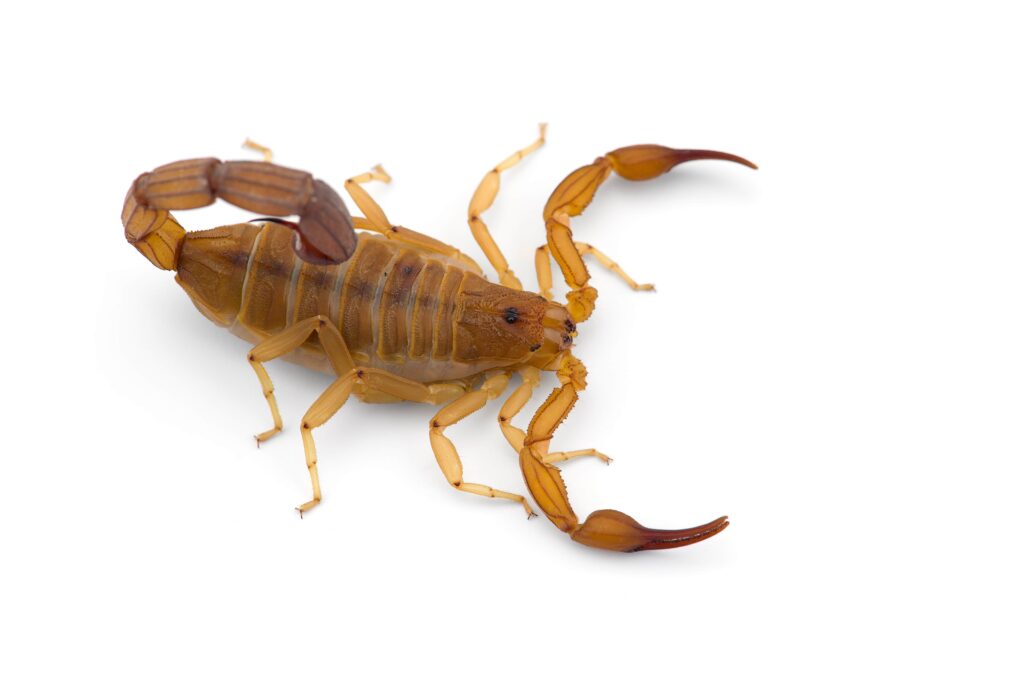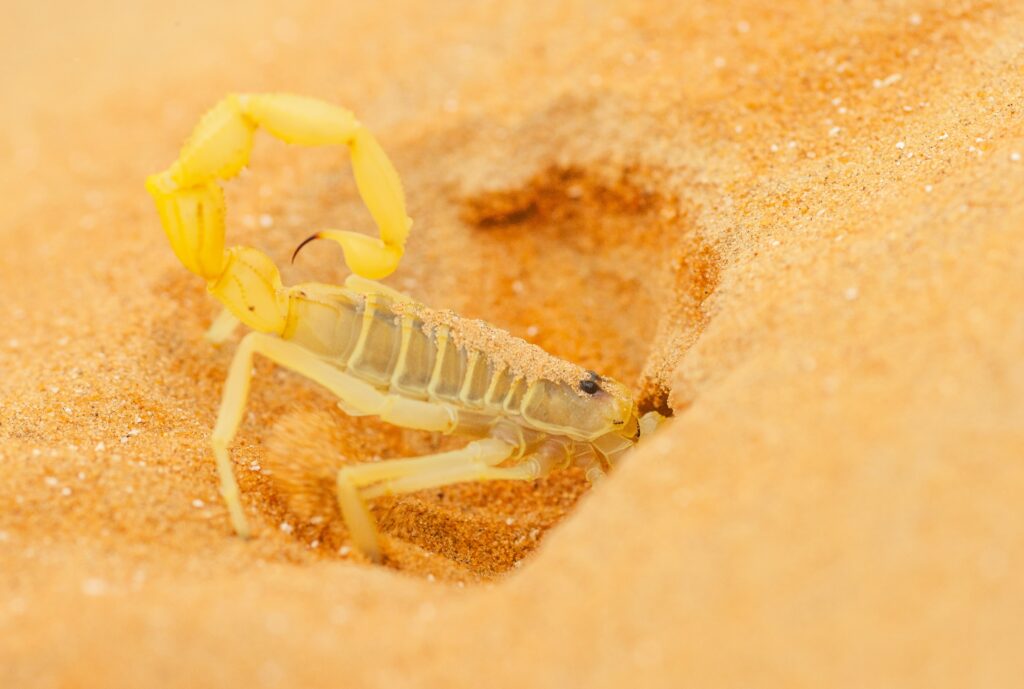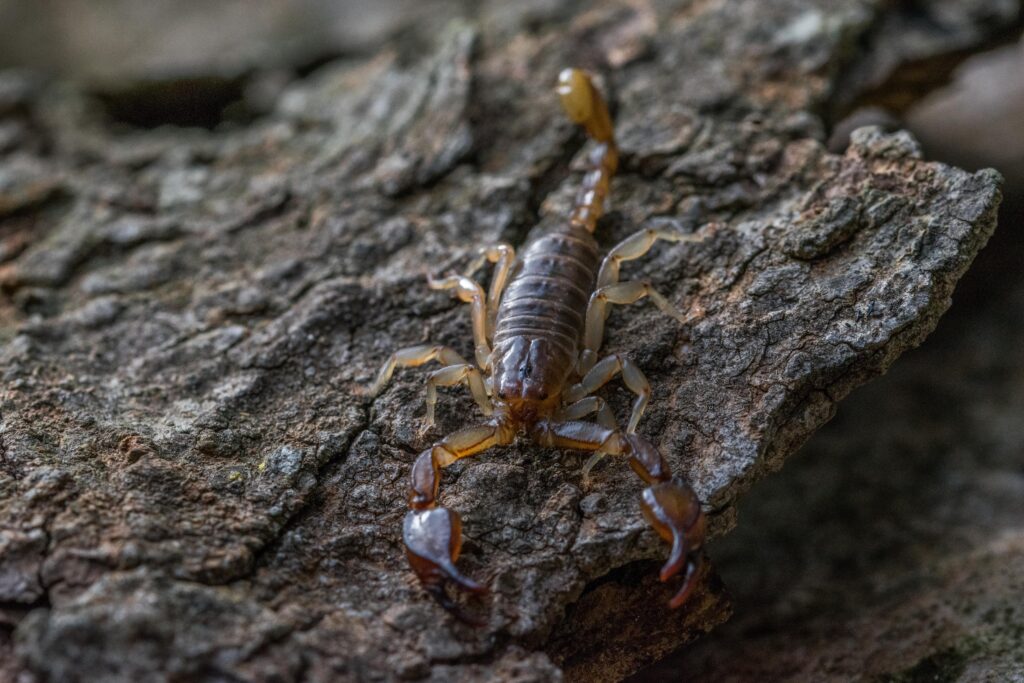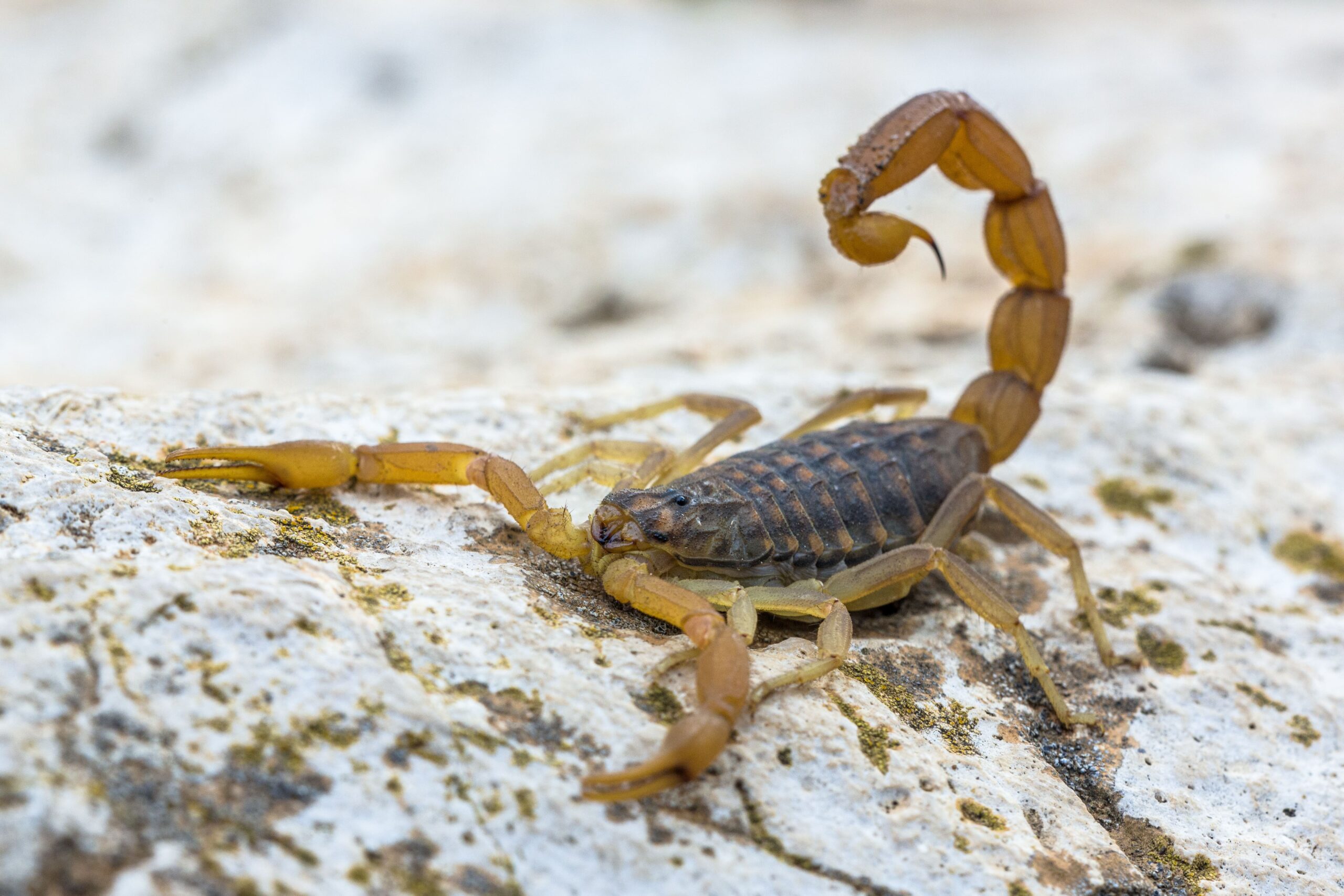In the vast desert landscapes of Nevada, where shimmering lights and bustling casinos dominate the scene, there lies a hidden secret – scorpions. These enigmatic creatures with their segmented bodies and venomous stingers have intrigued scientists and adventurers alike for centuries.
While scorpions may conjure images of dangerous creatures lurking in the shadows, the reality is more nuanced. In this article, we delve into the world of scorpions and explore a burning question that locals and visitors to Las Vegas often ponder: Are there bark scorpions in Las Vegas?
Scorpions, members of the Arachnida class, are fascinating arthropods known for their distinctive appearance – eight legs, a pair of pincers called pedipalps, and that menacing tail curved over their backs adorned with a venomous stinger. These nocturnal hunters have adapted to survive in various habitats worldwide but are particularly well-suited for desert environments.
They can be found in regions ranging from North America to Africa and Asia. Las Vegas itself is nestled within the Mojave Desert’s embrace—a harsh yet captivating landscape populated by an array of unique flora and fauna.
While commonly associated with glitz and glamour rather than wildlife, it’s essential to recognize that nature thrives even amidst bright lights and entertainment hubs. The question arises: do bark scorpions—the most venomous scorpion species in North America—have a presence in this desert oasis?
Let us embark on this journey together as we uncover the truth behind the mysterious presence of these intriguing creatures within Las Vegas’ limits. Stay tuned as we delve deeper into our investigation on whether or not bark scorpions are indeed found among Sin City’s bright neon signs or if other less dangerous scorpion species rule these desert lands.
We will also explore their preferred habitats and hiding places, as well as discuss ways to keep your family safe from potential encounters. Brace yourself for an adventure that will enlighten and empower you with knowledge about these intriguing arachnids that call Las Vegas their home.
Scorpions in Las Vegas
Picture this: a vast expanse of arid desert, bathed in the golden hues of the sun, stretching as far as the eye can see. In this seemingly inhospitable environment, where survival appears to be a constant battle against nature’s harsh elements, scorpions have carved out their niche.
Las Vegas, nestled amidst the Mojave Desert in Nevada, is no exception to their presence. Scorpions are no strangers to these desert regions and have adapted remarkably to thrive in such harsh conditions.
Understanding the Species Found in Las Vegas
Now you may be wondering, what makes it so important for us to understand which scorpion species call Las Vegas home? Well, it’s all about knowledge being power when it comes to coexisting with these fascinating creatures.
By identifying and understanding the species found in Las Vegas, we can better comprehend their habits and behaviors. Las Vegas is home to various scorpion species that differ not only in appearance but also in behavior and venom potency.
While bark scorpions steal much of the spotlight due to their venomous nature, there are other commonly found scorpions like desert hairy scorpions that also play a role in this ecosystem. Understanding these differences can help us differentiate between harmless pests and potentially dangerous encounters.
When venturing into the great outdoors or even within our own homes, knowing which scorpion species we might cross paths with allows us to take precautions accordingly. If you’re aware that bark scorpions are prevalent around your area, you’ll likely be more cautious while gardening or reaching into dark corners where they may hide during daylight hours.
So while Las Vegas may not be teeming with an overwhelming number of dangerous scorpions waiting around every corner (contrary to some imaginative fears), it certainly helps to know their presence and be prepared. In the next sections, we will delve into specific scorpion species found in Las Vegas, including the infamous bark scorpion and its intriguing adaptations for desert life.
Bark Scorpions: An Overview

Description and Unique Characteristics of Bark Scorpions
Bark scorpions, belonging to the Centruroides genus, are a fascinating group of arachnids that often strike fear into the hearts of those who encounter them. These creatures have a distinct appearance with their elongated bodies, eight legs, and characteristic curved tails ending in a barbed sting. They are typically light brown or tan in color, which allows them to blend seamlessly with their preferred habitats – crevices and cracks in bark or rocks.
Unlike most scorpions that glow under ultraviolet light, bark scorpions do not fluoresce, making them relatively harder to spot. What sets bark scorpions apart from other scorpion species is their venomous nature.
Their stings can be quite potent and painful for humans, especially if one has an allergic reaction or encounters a particularly dangerous species like the Arizona bark scorpion (Centruroides exilicauda). It’s important to note that not all bark scorpions found in Las Vegas are highly dangerous; however, caution should always be exercised when dealing with these critters.
Distribution and Habitats of Bark Scorpions Worldwide
Bark scorpions have managed to establish themselves across various regions worldwide. They are mainly found in arid environments such as deserts and semi-deserts due to their ability to adapt to harsh conditions. In North America alone, several species of bark scorpions exist, including the aforementioned Arizona bark scorpion which can be found throughout the southwestern United States.
Outside of North America, different species of Centruroides can be discovered throughout Central America and parts of South America. Additionally, some regions in Africa house unique varieties like the desert hairy scorpion (Hadrurus spadix) and emperor scorpion (Pandinus imperator).
These scorpions typically prefer cool and moist environments, unlike their desert-dwelling counterparts. While bark scorpions are widely distributed geographically, it’s essential to understand the specific species found in Las Vegas to address concerns of their presence and potential dangers.
Understanding the characteristics and global distribution of bark scorpions allows us to appreciate their adaptability and resilience in different habitats. In the following sections, we will delve deeper into the specific presence of bark scorpions in Las Vegas and explore ways to prevent encounters with these potentially dangerous creatures.
Bark Scorpion Species Found in North America
Identification and Distinguishing Features of North American Bark Scorpion Species

When it comes to scorpions in Las Vegas, two species that often come to mind are the Centruroides exilicauda, commonly known as the Arizona bark scorpion, and the Centruroides sculpturatus, also called the striped bark scorpion. Both species have distinctive characteristics that set them apart from most other scorpions found in North America.
The Arizona bark scorpion (Centruroides exilicauda) is one of the most common scorpions in Las Vegas and throughout the Sonoran Desert. It measures around 2.75 inches long on average and has a slender body with segmented tails.
The Arizona bark scorpion can be easily identified by its light tan to olive green color. It has pincers or claws called pedipalps that are relatively thin compared to other scorpions, making them look delicate.
On the other hand, the striped bark scorpion (Centruroides sculpturatus) shares some similarities with its Arizona counterpart but also possesses unique characteristics. This species ranges from light brown to yellowish-brown in coloration and appears slightly bulkier than the Arizona bark scorpion.
Its distinguishing feature is a distinct pattern of dark stripes along its back, which gives it its common name. These stripes run longitudinally down its segmented body, adding an aesthetically appealing element to this desert dweller.
It’s important to note that while these two species are commonly found in Nevada and particularly in Las Vegas, there are various other scorpion species inhabiting different regions across North America. Understanding their identification features helps residents and visitors alike recognize these arachnids and take necessary precautions when encountering them.
Remember: when dealing with any venomous creatures like these bark scorpions, it’s crucial to exercise caution. If stung, seek medical attention immediately.
Bark Scorpions in Nevada

Presence and Distribution of Bark Scorpions within Nevada State
When it comes to bark scorpions, Las Vegas, Nevada is no stranger to their presence. These venomous arachnids can be found throughout the state, but their concentration is particularly notable in the southern regions.
In fact, Las Vegas is known to be one of the hotspots for bark scorpion sightings in Nevada. While they can also be found in other areas of the state, it is in Las Vegas where encounters with these elusive creatures often occur more frequently.
Comparison with Other Regions in Nevada
While bark scorpions can be found across various parts of Nevada, there are some noticeable differences when comparing their presence in different regions. For instance, the abundance of bark scorpions tends to decrease as you move away from the southern areas like Las Vegas and approach more mountainous or cooler regions. This pattern suggests that environmental factors play a vital role in determining their distribution.
In urban areas such as Las Vegas, where human activity impacts natural habitats and introduces artificial environments like gardens and homes, there tends to be a higher likelihood of encountering bark scorpions. These adaptable creatures have managed to thrive within city limits due to abundant hiding places provided by landscaping features like rocks, plants, and even debris.
Factors Contributing to Their Presence
Several factors contribute to the prevalence of bark scorpions in Las Vegas and other parts of Nevada. Firstly, their preference for warm climates makes them well-suited for desert habitats like those found throughout much of the state. The arid environment provides a haven for these creatures who have evolved unique adaptations to conserve water efficiently and tolerate extreme temperatures.
Furthermore, human activities inadvertently create environments that attract these nocturnal creatures into residential areas. The practice of irrigating lawns and gardens, for example, can create a more hospitable environment for their prey, such as insects.
As a result, bark scorpions may follow their food sources into suburban settings. Additionally, the presence of ample hiding places like piles of rocks or wood, as well as dense vegetation around homes and in nearby landscapes, further entices bark scorpions to seek shelter in these areas.
So, while the prevalence of bark scorpions may vary across different regions of Nevada, Las Vegas stands out as an area where encounters are more likely due to its unique combination of desert climate and human-modified habitats. Stay tuned for our next section where we delve into the fascinating adaptations that enable these bark scorpions to thrive amidst the arid landscapes of Las Vegas and beyond!
The Bark Scorpion’s Adaptations for Desert Life

In the scorching desert landscapes of Las Vegas, where water is scarce, survival becomes a remarkable feat. Bark scorpions possess unique physiological adaptations that allow them to conserve water efficiently.
Their exoskeleton acts as a protective barrier against dehydration by minimizing water loss through evaporation. This thick, waxy layer prevents moisture from escaping their bodies, enabling them to thrive in arid conditions for extended periods.
Furthermore, these resourceful creatures possess an incredible ability to regulate their metabolic rate. By lowering their metabolic activity during periods of limited water availability, they reduce the amount of water needed for vital bodily functions such as respiration and digestion.
This adaptation ensures they can survive longer without access to fresh water sources. To supplement their water requirements, bark scorpions have developed efficient hunting strategies that optimize hydration intake while conserving energy expenditure.
They often prey upon small insects that contain high moisture content. By selectively targeting such prey items, bark scorpions obtain not only sustenance but also a valuable source of hydration in their harsh desert habitat.
Endurance in Extreme Temperatures: Heat Tolerance Mechanisms

Las Vegas is notorious for its blazing summers, with temperatures soaring well above 100 degrees Fahrenheit. In this oven-like environment, the ability to withstand extreme heat becomes crucial for survival.
Bark scorpions possess remarkable heat tolerance mechanisms that keep them thriving even in these harsh conditions. These resilient creatures have adapted specialized respiratory structures known as spiracles located on their exoskeletons.
Through these tiny openings, they can control airflow and regulate body temperature more effectively than many other species of scorpions found around the world. Moreover, bark scorpions are known for their skillful use of shelters to escape intense heat.
They seek refuge in cool, shaded areas during the day, such as under rocks or in crevices. By minimizing exposure to direct sunlight, they reduce the risk of overheating and maintain an optimal body temperature for survival.
In addition, their nocturnal behavior allows them to avoid the scorching heat of the day altogether. Active primarily during the cooler nighttime hours, bark scorpions emerge from their hiding places to hunt for prey that becomes more abundant after sunset.
By conserving water efficiently and possessing remarkable heat tolerance mechanisms, bark scorpions have mastered the art of surviving in Las Vegas’ arid and sweltering desert environment. These fascinating adaptations enable them to thrive where many other creatures struggle to endure.
Behavior and Venomous Nature of Bark Scorpions
Nocturnal Habits and Hiding Places During the Day
Bark scorpions, like most other scorpions, are primarily nocturnal creatures. They spend their days hiding in dark, secluded areas to avoid exposure to the scorching desert sun. In Las Vegas, these crafty arachnids often seek refuge under rocks, logs, or shady crevices.
They have a remarkable ability to flatten their bodies, allowing them to squeeze into tight spaces such as cracks in walls or beneath floorboards. It is not uncommon for bark scorpions to find shelter in cool basements or even dark closets within homes.
Hunting Techniques, Prey, and Feeding Habits

When night falls and darkness blankets Las Vegas, bark scorpions emerge from their hiding spots in search of food. Using their eight legs and sensitive pincers, they navigate their way through desert landscapes with impressive agility.
Unlike some other scorpion species that rely solely on venomous stings for prey capture, bark scorpions possess a more diverse hunting strategy. These skilled predators primarily feed on insects such as cockroaches and crickets that they can easily overpower with their venomous sting.
When prey is located, the bark scorpion uses its pincers to grasp the unfortunate victim before delivering a swift and paralyzing sting. Once immobilized, the bark scorpion uses its powerful mouthparts to tear apart the prey’s exoskeleton before consuming it.
Venom Potency: Effects on Humans and Medical Importance
The venom of a bark scorpion found in Las Vegas is potent compared to many other types of scorpions worldwide. The Arizona bark scorpion (Centruroides exilicauda) and the striped bark scorpion (Centruroides sculpturatus) are the two species commonly encountered in the Las Vegas area. Their venom contains neurotoxins that can cause severe pain, swelling, and discomfort.
In some cases, especially for vulnerable individuals such as young children or those with allergies, a bark scorpion sting can be dangerous and may require immediate medical attention. While most bark scorpion stings result in localized symptoms like intense pain and tingling sensations around the sting site, systemic effects such as muscle spasms and breathing difficulties can occur in severe cases.
It is crucial to exercise caution and take preventive measures to minimize the risk of encountering these fascinating yet potentially harmful creatures in Las Vegas. Remember, awareness of their behavior, understanding their hunting techniques, and knowledge about their venomous nature are integral to staying safe when coexisting with nature’s wonders like the bark scorpions found in Las Vegas.
Preventing Encounters with Bark Scorpions in Las Vegas
Tips for minimizing chances of encountering a bark scorpion at home or outdoors
To ensure the safety of your Las Vegas home and keep your family safe from potential encounters with bark scorpions, it is crucial to be proactive in implementing preventive measures. Firstly, it is essential to understand that bark scorpions are nocturnal creatures that seek shelter during the day.
Therefore, sealing any cracks or openings in your home’s foundation, windows, and doors can significantly reduce their entry points. Additionally, installing door sweeps and weather stripping can further fortify your defense against these unwanted guests.
Another effective strategy is to eliminate their hiding spots by decluttering both indoors and outdoors. Removing piles of wood or rocks near your property reduces the likelihood of attracting bark scorpions as these provide them with ideal shelter.
Regularly trimming vegetation around your house and keeping the grass well-maintained also discourages them from making themselves at home. When spending time outdoors, take precautionary measures to minimize the risk of an encounter.
Before sitting down or reaching into areas where scorpions could be hiding, such as woodpiles or dense vegetation, inspect the surroundings carefully. Wearing closed-toe shoes and using a flashlight while walking around after sunset can provide an extra layer of protection against accidental encounters.
Importance
Understanding the importance of preventing encounters with bark scorpions goes beyond mere peace of mind; it is a matter of safety for you and your loved ones. While most species do not pose significant threats to humans unless provoked or surprised, their stings can cause pain and discomfort.
In rare cases where individuals may have allergies or sensitivities to venomous stings, an encounter with a bark scorpion can lead to more severe reactions that require medical attention. Moreover, taking preventive measures against bark scorpions plays a crucial role in preserving the delicate ecosystem balance.
Bark scorpions feed on various insects, including cockroaches and other pests that are often considered nuisances. By keeping their population in check, we contribute to a healthier environment and reduce the presence of potential threats to our homes.
Conclusion
Living in Las Vegas does come with the possibility of encountering bark scorpions. However, by implementing simple yet effective preventive measures, such as sealing openings in your home, decluttering both indoors and outdoors, and being cautious when spending time outside after dark, you can greatly minimize the chances of unpleasant encounters. Remember that prevention is key to maintaining a peaceful coexistence with these creatures.
Feel reassured knowing that bark scorpions are generally more fearful of us than we are of them. With vigilance and proper precautions in place, you can enjoy your time in Las Vegas without feeling threatened by these small arachnids.
By taking care of your surroundings and understanding their habits and habitats, you can create an environment that is both welcoming for humans while discouraging for bark scorpions. Stay informed, stay safe!
Conquering Scorpions with D-Termination: Las Vegas’ Leading Pest Control Solution!

Troubled by the presence of scorpions in your Las Vegas property? D-Termination is here to offer you a solution. Our team of adept professionals is specialized in eradicating these venomous pests and ensuring the restoration of safety within your premises. Bid farewell to your concerns about scorpions and make the smart choice by opting for D-Termination’s effective pest control services today!
To secure your scorpion control service and regain control over your space from these unsettling pests, get in touch with us at 702-919-6310 or visit dtermination.com.
Frequently Asked Questions:
Bark scorpions are relatively common in Las Vegas.
Yes, bark scorpions are found in Nevada.
Scorpion populations are particularly noticeable in suburban areas near desert landscapes in Las Vegas.
Some scorpion species in Las Vegas, like the bark scorpion, are venomous.








